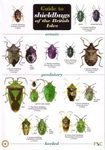![Palaeoaphididae (Hemiptera, Sternorrhyncha) from Lower Cretaceous Baissa Deposits Palaeoaphididae (Hemiptera, Sternorrhyncha) from Lower Cretaceous Baissa Deposits]()
Click to have a closer look
About this book
Customer reviews
Related titles
About this book
Language: English
Baissa is one of the best known and richest places where imprints of insects come from. It is situated in Transbaikalia on the territory of Buryatia at the bank of the Vitim River. There are over 20 000 insects in the collection of the Paleontological Institute RAS in Moscow. Aphids are among the most numerous groups of the terrestrial animals (30%). One of the aphid families represented in this material is Palaeoaphididae (447 specimens). So far this group has been little studied. Analyses of the morphological structure and taxonomical differences among representatives of this family have been carried out. Research was conducted with the use of light microscope and scanning electron microscope. Because of the type of deposits and retained parts of the skeleton, 98% ethyl alcohol was used to enable observation and analysis and to improve the quality of the photographs. Thanks to the digital recordings, it was possible to take measurements with the software Lucia-net v. 4.60. For quantitative analysis, statistical methods were also used, such as the Pearson formula or χ2 test. Calculations were performed using Statistica software for Windows v. 5.0. To analyse the mode of life of Palaeoaphididae aphids from Baissa, the index of antennae was used as proposed by Shaposhnikov (1980).
In the conducted analyses, 32 new taxa of different ranks were identified: Bugyrorinaphis gen. nov., Buriataphis gen. nov., Rallotopaphis gen, nov., Rinorectuaphis gen. nov., Transbaikalis gen. nov., Unioaphis gen. nov., Annulaphis mostovskini sp. nov., Bugyrorinaphis unica sp. nov., Buriataphis soporata sp. nov., Caudaphis angustivola sp. nov., Caudaphis brevicrura sp. nov., Caudaphis longiantennata sp. nov., Caudaphis modica sp. nov., Caudaphis vulgata sp. nov., Ellinaphis bulla sp. nov., Ellinaphis cubocrassa sp. nov., Ellinaphis curta sp. nov., Ellinaphis elegans sp. nov., Ellinaphis eserta sp. nov., Ellinaphis extenda sp. nov., Ellinaphis longistigma sp. nov., Ellinaphis mirabila sp. nov., Ellinaphis premordica sp. nov., Ellinaphis truncata sp. nov., Rallotopaphis antennata sp. nov., Rinorectuaphis abortiva sp. nov., Rinorectuaphis connexa sp. nov., Rinorectuaphis fida sp. nov., Rinorectuaphis sejuncta sp. nov., Transbaikalis furcata sp. nov., Unioaphis venusta sp. nov. Among them is the new subfamily Ellinaphidinae subfam. nov.
Most specimens belong to the genus Ellinaphis, which makes up over 30% of all specimens from the Early Cretaceous family of Palaeoaphididae. As for species, Ellinaphis is the most diversified genus. Basing on previous ecological and climatic characteristics of every geological layer from Baissa, an analysis of climatic preferences of aphids that lived in that time on this territory has been carried out. Fossil aphids, also Early Cretaceous Palaeoaphididae, like the majority of recent aphids, should be considered as an indicator of colder and more humid climate.
Customer Reviews























![Hémiptères de France, de Belgique, du Luxembourg et de Suisse [Hemiptera of France, Belgium, Luxembourg and Switzerland]](http://mediacdn.nhbs.com/jackets/jackets_resizer_medium/22/226274.jpg?height=150&width=106)
![Tentōmushi: Getcho Sensei no Tentoumushikorekushon [Ladybirds: Mr. Getcho's Ladybird Collection]](http://mediacdn.nhbs.com/jackets/jackets_resizer_medium/26/264269.jpg?height=150&width=108)







![Die Familie Parasitidae Oudemans, 1901 (Acarina, Mesostigmata) [The Family Parasitidae Ondemans, 1901 (Acarina, Mesostigmata)]](http://mediacdn.nhbs.com/jackets/jackets_resizer_medium/20/201089.jpg?height=150&width=108)



